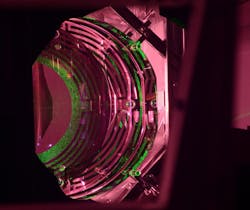Advanced Laser Interferometer Gravitational-Wave Observatory (LIGO) to begin scientific observations
The Advanced LIGO Project, a major upgrade of the Laser Interferometer Gravitational-Wave Observatory, will begin scientific observations mid-September, 2015. LIGO, which was designed and is operated by the California Institute of Technology (Caltech; Pasadena, CA) and the Massachusetts Institute of technology (MIT; Cambridge, MA) with funding from the National Science Foundation (NSF), consists of identical interferometer-based gravitational-wave detectors in Livingston, Louisiana, and Hanford, Washington. The L-shaped interferometers, with evacuated arms several kilometers long, are designed to observe cosmological gravitational waves—ripples in the fabric of space and time produced by events such as the merger of two neutron stars or black holes.
"Experimental attempts to find gravitational waves have been on going for over 50 years, and they haven't yet been found. They're both very rare and possess signal amplitudes that are exquisitely tiny," says David Reitze, the executive director of the LIGO program at Caltech.
Although earlier LIGO runs revealed no detections, Advanced LIGO, also funded by the NSF, increases the sensitivity of the observatories by a factor of 10, resulting in a thousandfold increase in observable candidate objects. "The first Advanced LIGO science run will take place with interferometers that can 'see' events more than three times further than the initial LIGO detector, so we'll be probing a much larger volume of space," says David Shoemaker, the MIT Advanced LIGO project leader.
While earlier LIGO observing runs did not confirm the existence of gravitational waves, the influence of such waves has been measured indirectly via observations of a binary system called PSR B1913+6. The system consists of two objects, both neutron stars that orbit a common center of mass. The orbits of these two stellar bodies have been observed to be slowly contracting due to the energy that is lost to gravitational radiation. Binary star systems such as these that are in the very last stages of evolution, just before and during the inevitable collision of the two objects, are key targets of the planned observing schedule for Advanced LIGO.
"Ultimately, Advanced LIGO will be able to see 10 times as far as initial LIGO and, based on theoretical predictions, should detect many binary neutron star mergers per year," Reitze says.
The improved instruments will be able to look at the last minutes of the life of pairs of massive black holes as they spiral closer together, coalesce into one larger black hole, and then vibrate as they merge. Advanced LIGO also will be able to pinpoint periodic signals from the many known pulsars that radiate in the range of 10 to 1,000 Hertz (frequencies that roughly correspond to low and high notes on an organ). In addition, Advanced LIGO will be used to search for the gravitational cosmic background, allowing tests of theories about the development of the universe only 10-35 seconds after the Big Bang.
"We expect it will take five years to fully optimize the detector performance and achieve our design sensitivity," Reitze says.
Source: http://www.caltech.edu/news/advanced-ligo-begin-operations-47898
About the Author
John Wallace
Senior Technical Editor (1998-2022)
John Wallace was with Laser Focus World for nearly 25 years, retiring in late June 2022. He obtained a bachelor's degree in mechanical engineering and physics at Rutgers University and a master's in optical engineering at the University of Rochester. Before becoming an editor, John worked as an engineer at RCA, Exxon, Eastman Kodak, and GCA Corporation.

